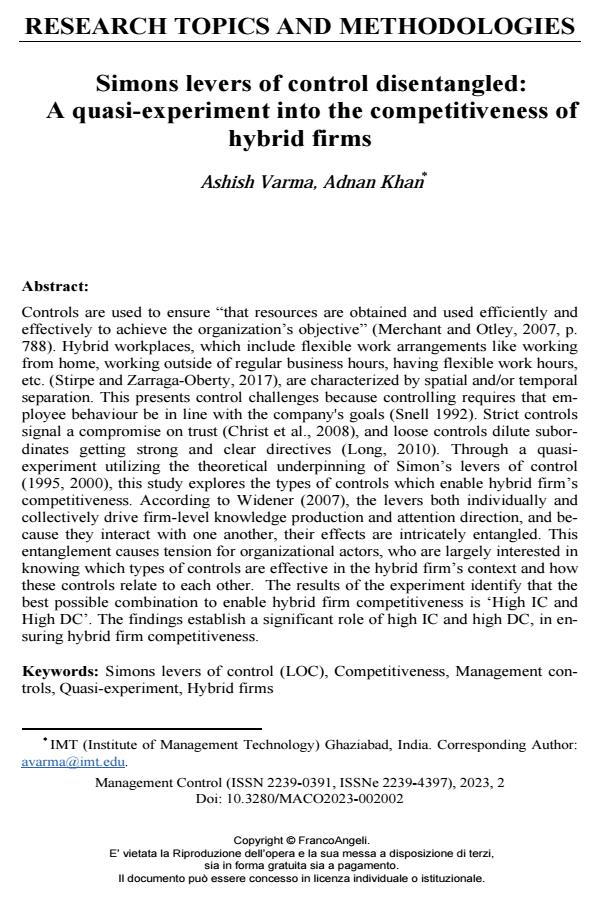Simons levers of control disentangled: A quasi-experiment into the competitiveness of hybrid firms
Titolo Rivista MANAGEMENT CONTROL
Autori/Curatori Ashish Varma, Adnan Khan
Anno di pubblicazione 2023 Fascicolo 2023/2
Lingua Inglese Numero pagine 23 P. 19-41 Dimensione file 311 KB
DOI 10.3280/MACO2023-002002
Il DOI è il codice a barre della proprietà intellettuale: per saperne di più
clicca qui
Qui sotto puoi vedere in anteprima la prima pagina di questo articolo.
Se questo articolo ti interessa, lo puoi acquistare (e scaricare in formato pdf) seguendo le facili indicazioni per acquistare il download credit. Acquista Download Credits per scaricare questo Articolo in formato PDF

FrancoAngeli è membro della Publishers International Linking Association, Inc (PILA)associazione indipendente e non profit per facilitare (attraverso i servizi tecnologici implementati da CrossRef.org) l’accesso degli studiosi ai contenuti digitali nelle pubblicazioni professionali e scientifiche
Controls are used to ensure “that resources are obtained and used efficiently and effectively to achieve the organization’s objective” (Merchant and Otley, 2007, p. 788). Hybrid workplaces, which include flexible work arrangements like working from home, working outside of regular business hours, having flexible work hours, etc. (Stirpe and Zarraga-Oberty, 2017), are characterized by spatial and/or tem-poral separation. This presents control challenges because controlling requires that employee behaviour be in line with the company's goals (Snell 1992). Strict con-trols signal a compromise on trust (Christ et al., 2008), and loose controls dilute subordinates getting strong and clear directives (Long, 2010). Through a quasi-experiment utilizing the theoretical underpinning of Simon’s levers of control (1995, 2000), this study explores the types of controls which enable hybrid firm’s competitiveness. According to Widener (2007), the levers both individually and collectively drive firm-level knowledge production and attention direction, and be-cause they interact with one another, their effects are intricately entangled. This entanglement causes tension for organizational actors, who are largely interested in knowing which types of controls are effective in the hybrid firm’s context and how these controls relate to each other. The results of the experiment identify that the best possible combination to enable hybrid firm competitiveness is ‘High IC and High DC’. The findings establish a significant role of high IC and high DC, in ensuring hybrid firm competitiveness.
Parole chiave:Simons levers of control (LOC), Competitiveness, Management con-trols, Quasi-experiment, Hybrid firms
- Assessing the Impact of Accounting Analytic Capabilities on Firm Performance Ashish Varma, Anuj Sharma, in Journal of Computer Information Systems /2025 pp.738
DOI: 10.1080/08874417.2024.2329137 - Accounting-Analytic Capabilities’ Impact on Management Controls and Performance Ashish Varma, Anuj Sharma, Adnan Khan, in Journal of Computer Information Systems /2025 pp.1
DOI: 10.1080/08874417.2024.2441770
Ashish Varma, Adnan Khan, Simons levers of control disentangled: A quasi-experiment into the competitiveness of hybrid firms in "MANAGEMENT CONTROL" 2/2023, pp 19-41, DOI: 10.3280/MACO2023-002002